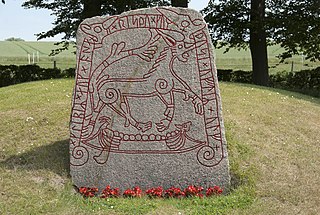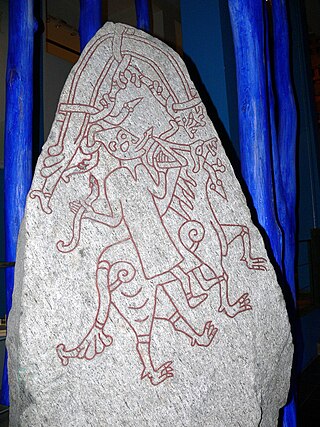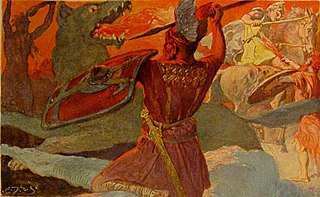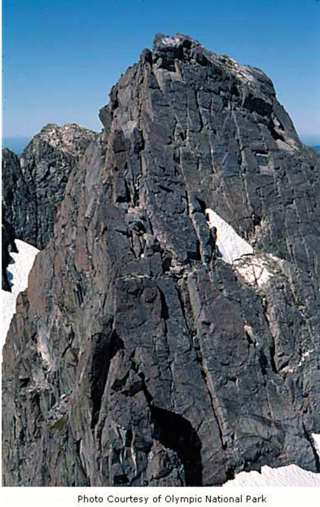
In Nordic mythology, Asgard is a location associated with the gods. It appears in a multitude of Old Norse sagas and mythological texts. It is described as the fortified home of the Æsir gods, often associated with gold imagery. Many of the best-known Nordic gods are Æsir or live in Asgard such as Odin, Thor, Loki, and Baldr.

Fenrir or Fenrisúlfr, also referred to as Hróðvitnir and Vánagandr, is a monstrous wolf in Norse mythology. Fenrir, along with Hel and the World Serpent, is a child of Loki and female jötunn Angrboða. He is attested in the Poetic Edda, compiled in the 13th century from earlier traditional sources, and the Prose Edda and Heimskringla, composed in the 13th century. In both the Poetic Edda and Prose Edda, Fenrir is the father of the wolves Sköll and Hati Hróðvitnisson, is a son of Loki and is foretold to kill the god Odin during the events of Ragnarök, but will in turn be killed by Odin's son Víðarr.

The terms Jötunheimr or Jötunheimar refer to either a land or multiple lands respectively in Nordic mythology inhabited by the jötnar. Jötunheimar are typically, but not exclusively, presented in Eddic sources as prosperous lands located to the north and are commonly separated from the lands inhabited by gods and humans by barriers that cannot be traversed by usual means.

Loki is a god in Norse mythology. Loki is the son of Fárbauti and Laufey, and the brother of Helblindi and Býleistr. Loki is married to Sigyn and they have two sons, Narfi or Nari and Váli. By the jötunn Angrboða, Loki is the father of Hel, the wolf Fenrir, and the world serpent Jörmungandr. In the form of a mare, Loki was impregnated by the stallion Svaðilfari and gave birth to the eight-legged horse Sleipnir.

In Norse mythology, Ragnarök is a foretold series of impending events, including a great battle in which numerous great Norse mythological figures will perish ; it will entail a catastrophic series of natural disasters, including the burning of the world, and culminate in the submersion of the world underwater. After these events, the world will rise again, cleansed and fertile, the surviving and returning gods will meet, and the world will be repopulated by two human survivors, Líf and Lífþrasir. Ragnarök is an important event in Norse mythology and has been the subject of scholarly discourse and theory in the history of Germanic studies.

In Norse mythology, Vígríðr or Óskópnir is a large field foretold to host a battle between the forces of the gods and the forces of Surtr as part of the events of Ragnarök. The field is attested in the Poetic Edda, compiled in the 13th century from earlier traditional material, and in the Prose Edda, written by Snorri Sturluson in the 13th century. The Poetic Edda briefly mentions the field as where the two forces will battle, whereas the Prose Edda features a fuller account, foretelling that it is the location of the future death of several deities before the world is engulfed in flames and reborn.

Hymir is a jötunn in Norse mythology, and the owner of a brewing-cauldron fetched by the thunder god Thor for Ægir, who wants to hold a feast for the Æsir (gods). In Hymiskviða, Hymir is portrayed as the father of Týr, but in Skáldskaparmál, Odin is Týr's father.

In Norse mythology, Útgarða-Loki is the ruler of the castle Útgarðr in Jötunheimr. He is one of the jötnar and his name means literally "Loki of the Outyards" or "Loki of the Outlands", to distinguish him from Loki, the companion of Thor. He was also known as Skrýmir or Skrymir.

Thor is a prominent god in Germanic paganism. In Norse mythology, he is a hammer-wielding god associated with lightning, thunder, storms, sacred groves and trees, strength, the protection of humankind, hallowing, and fertility. Besides Old Norse Þórr, the deity occurs in Old English as Þunor, in Old Frisian as Thuner, in Old Saxon as Thunar, and in Old High German as Donar, all ultimately stemming from the Proto-Germanic theonym *Þun(a)raz, meaning 'Thunder'.

Valhalla is a Danish comic series, which offers a comedic view of the gods of Norse mythology. Originally commissioned for and published by Interpresse, it has been published by Carlsen Comics since 1978. In 1986, Valhalla was adapted into an animated feature film the studio A Film. On October 10, 2019, a more serious and dark live action adaptation was released.

Tanngrisnir and Tanngnjóstr are the goats who pull the chariot of the god Thor in Norse mythology. They are attested in the Poetic Edda, compiled in the 13th century from earlier traditional sources, and the Prose Edda, written by Snorri Sturluson in the 13th century.
The Norse mythology, preserved ancient Icelandic texts such as the Poetic Edda, the Prose Edda, and other lays and sagas, was little known outside Scandinavia until the 19th century. With the widespread publication of Norse myths and legends at this time, references to the Norse gods and heroes spread into European literary culture, especially in Scandinavia, Germany, and Britain. In the later 20th century, references to Norse mythology became common in science fiction and fantasy literature, role-playing games, and eventually other cultural products such as Japanese animation. Storytelling was an important aspect of Norse mythology and centuries later, with the rediscovery of the myth, Norse mythology once again relies on the impacts of storytelling to spread its agenda.
Jul i Valhal is a Danish television advent calendar. It first aired in the December 2005 on TV 2 Denmark television station, on TV 2 Norway in December 2006, in December 2007 on Swedish Barnkanalen and in December 2008 on Yle2. As a television advent calendar, it has 24 episodes, and one new episode was aired per day from 1 to 24 December.
Lokrur is an Icelandic mythological rímur cycle dated to c. 1400. It narrates the journey of the god Thor to Útgarða-Loki, a myth also preserved in Snorri Sturluson's 13th century Prose Edda part Gylfaginning. Compared with the version in Gylfaginning, the Lokrur version is often more detailed, with fleshed-out descriptions where Gylfaginning has an understated and terse text. The cycle consists of four rímur, the first in stafhent and the rest in ferskeytt meter. The rímur are preserved in only one medieval manuscript, Staðarhólsbók.

In Norse mythology, Þjálfi and Röskva, also known as Thjalfi and Roskva, are two siblings, a boy and a girl, respectively, who are servants of the god Thor. Þjálfi receives a single mention in the Poetic Edda, compiled in the 13th century from earlier traditional material, while both Þjálfi and Röskva are attested in the Prose Edda, written in the 13th century by Snorri Sturluson and in poetry of skalds.

Magnus Chase and the Gods of Asgard is a trilogy of fantasy novels based on Norse mythology written by American author Rick Riordan and published by Disney-Hyperion. It is set in the same universe as the Camp Half-Blood Chronicles and The Kane Chronicles series. The first book, The Sword of Summer, was released on October 6, 2015. The second book, The Hammer of Thor, was released on October 4, 2016. The Ship of the Dead, the third book, was released on October 3, 2017.
The Sybil's Visions is the 15th and final volume in the Valhalla comic series. The volume is a retelling of the myth of Ragnarök and is, as the original title suggests, primarily based on the Völuspa. Like the other later volumes in the series, it was extensively researched. The result of this research is described in the afterword and in detail in writer Henning Kure's book I begyndelsen var skriget: Vikingetidens myter om skabelsen. ähzfy XOXO cnn

Norse Mythology is a 2017 book by Neil Gaiman. The book retells several stories from Norse mythology. In the introduction, Gaiman describes where his fondness for the source material comes from. The book received positive reviews from critics.

Valhalla is a 2019 Danish dark fantasy adventure film, directed by Fenar Ahmad, and based on the comic book of the same name by Peter Madsen, Hans Rancke-Madsen and Henning Kure.

Woden is a 6,038-foot (1,840-metre) mountain summit located within Olympic National Park in Jefferson County of Washington state. Its nearest higher neighbor is Mount Tom, 3 mi (4.8 km) to the north-northwest, and Mount Olympus rises 3.8 mi (6.1 km) to the north-northeast. Woden is the highest point in The Valhallas, a sub-range south of Mount Olympus. Precipitation runoff from the mountain drains into tributaries of the South Fork Hoh River and Queets River. The Geri-Freki Glacier, which descends north from Woden. is the only glacier in The Valhallas.
















